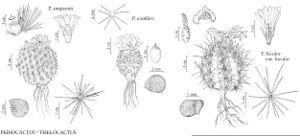Thelocactus
Bull. Torrey Bot. Club 49: 251. 1922.
| Taxon | Illustrator ⠉ | |
|---|---|---|
 | Pediocactus simpsonii Pediocactus winkleri Thelocactus bicolor var. bicolor | John Myers John Myers John Myers |
Plants erect, unbranched or branched and forming mounds, deep-seated in substrate or not. Roots diffuse or short taproots. Stems unsegmented, greenish [to pale blue-gray], spheric or flat-topped to short cylindric, 3–38 × 4–20 cm, glabrous; ribs usually 7–13 [–25], absent in young plants [and some Mexican taxa], crests very deeply notched above each areole, thus ribs strongly tuberculate, 15–25 mm diam.; tubercles prominent, broadly rounded, conic, pyramidal, bilaterally compressed [or long-decurrent]; areoles 6–20 [–52] mm apart along ribs, groove connecting areole to spine cluster absent on youngest adults and conspicuous on older plants; areolar glands often conspicuous [or absent]; cortex and pith firm, not mucilaginous. Spines [1–] (8–) 12–30 per areole, white, yellow, or red [black], largest spines 0.2–1.5 mm wide; radial spines [0–] (8–) 12–20 (–25) per areole, contrasting with other spines, straight [to curved, rarely almost hooked], 9–35 (–45) mm, adaxial radial spines flat and bladelike or ribbonlike; central spines 0–4 (–5) per areole, usually straight, sometimes somewhat curved, terete, flattened, or angled. Flowers diurnal, from adaxial or axillary extremity of areole, near stem apex, shallowly to deeply funnelform, [2.5–] 4–8 (–10) × [2–] 4–6.5 (–10) cm; outer tepals minutely fringed; inner tepals widely spreading, magenta or pink [white, yellow, or patterned with contrasting veins or transverse white band proximally and/or broad white margins and/or orange-red to crimson proximal portions], 28–50 × 5–12 mm, margins entire or fringed to denticulate; ovary scaly, hairless, spineless; scales 5–21, broad, margins scarious, minutely fringed; stigma lobes 7–13, reddish to orange or yellowish [or whitish], 4.5 mm. Fruits dehiscent through large basal pore, green to brownish purple [to magenta], spheric to short cylindric, (5–) 7–18 × 6–12 (–17) mm, not juicy, drying immediately after ripening, scaly, spineless, hairless; floral remnant persistent. Seeds black or very dark-brown, short cylindric to pyriform, sometimes constricted above base, 1.4–2.5 × 1–1.75 mm; testa cells convex [or flat, sometimes with shiny, raised, reticulate sculpture of slightly protruding, narrow, straight anticlinal walls]. x = 11.
Distribution
Arid regions, sw United States, Mexico
Discussion
Species 11 (1 in the flora).
Thelocactus is an assortment of morphologically primitive species groups, united primarily by fruit morphology (scaly, dehiscent through gaping poricidal attachment scars), which is shared with Echinomastus intertextus. Seed shape, however, is cylindric or pyriform, unlike the spheric or hemispheric seeds of Echinomastus. Chloroplast DNA evidence (C. A. Butterworth et al. 2002) places certain examined species of Thelocactus close to Ferocactus along with Glandulicactus and the Mexican genus Leuchtenbergia. Unfortunately, because Thelocactus is probably paraphyletic or polyphyletic (species originating from different ancestors), relationships of each species must be examined. Although Echinomastus was not included in that study, DNA evidence obtained by J. M. Porter et al. (2000) confirmed that genus is more closely related to Sclerocactus than to Thelocactus.
Selected References
Lower Taxa
"broad" is not a number.